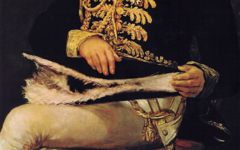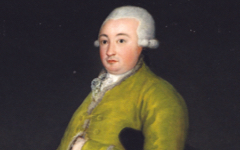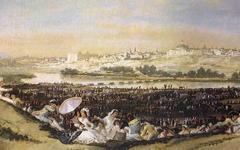Goya’s 2nd May, 1808 (1814)
Goya’s May Second, 1808 is supposed to depict the dramatic events that took place on that day in Madrid though it has been described by Hugh Thomas as “staged opera.”1 That is a good description though misleading. What Thomas missed is the exception and it is always there, in the inconsistencies, errors and mysteries where meaning is found. You need to look out for them.
Most of the figures are relatively shallow, spread out across the vast canvas like decorative elements on a flat surface. The exception is the man in the green jacket and yellow breeches in the lower right-hand corner who stabs the white horse with a dagger. His figure is different; spot-lit, fully rounded, almost in 3-D, and he moves into the picture. He, no writer has yet noted, is the “painter”.
Click next thumbnail to continue

Top: Goya, May 2nd 1808
Bottom: Goya, Family of Infante Don Luis with detail and diagram
Click image to enlarge.
Goya’s alter ego in a green jacket, the color of fertility, uses his dagger to “paint” the horse. Blood (so often a symbol for paint) spurts from the point where his “brush” makes contact. The other figures, painted on a backdrop with an impossibly perspectival view of the plaza behind, are “in his painting” because what we are looking at is a “scene in a studio.” In support, the painter crouches in a similar way in the lower left-hand corner of his earlier Family of Infante Don Luis (below), his head also turned towards his model in concentration.
Click next thumbnail to continue
Now study the horse, horizontally placed across the canvas, in front of Goya’s “alter ego”. The horse is an easel because horse and easel are the same word in Spanish: “caballete”. And its flank, white like an unpainted canvas, is touched by Goya’s "brush".
Here, in the studio of the artist's mind, various aspects of Goya struggle to create the image. As explained in entries on Manet's Le Déjeuner sur l'Herbe (1863) and other masterpieces, the painting and studio are combined.
Click next thumbnail to continue
The historical accuracy of the Mamluk attire has often been questioned. Goya probably used their clothing because he needed their turbans to signify that all the fighters are an aspect of his own mind.2 Numerous great masters, from Van Eyck to Rembrandt, had worn turbans in their self-portraits and they were commonly used in studios to keep paint off their hair.3
See conclusion below.
Lastly, a brief note on an element that deserves more attention: just as great portraits are not historical documents nor are great “history” paintings either. If they were, they probably would not be art. True artists only ever paint their own minds in the act of creation as Goya does here. He has depicted the mental struggle - the blood, toil, tears and sweat – that it took to create the image.
More Works by Goya
Notes:
1. Hugh Thomas, Goya: The Third of May 1808 (New York: Viking Press) 1972, p. 85
2. The French-looking uniforms worn by the Mexican soldiers in Manet's Execution of Emperor Maximilian have also been questioned because it is doubtful that the actual squad was dressed like that. Manet, of course, like Goya, was more concerned with his own poetic message than historical accuracy.
3. See Filippino Lippi's Dead Christ (c.1500) and the Artist's Turban.
Original Publication Date on EPPH: 08 Sep 2010. | Updated: 0. © Simon Abrahams. Articles on this site are the copyright of Simon Abrahams. To use copyrighted material in print or other media for purposes beyond 'fair use', you must obtain permission from the copyright owner. Websites may link to this page without permission (please do) but may not reproduce the material on their own site without crediting Simon Abrahams and EPPH.






